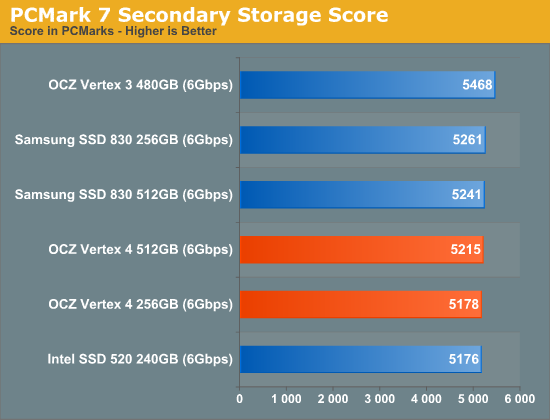OCZ Vertex 4 Review (256GB, 512GB)
by Anand Lal Shimpi on April 4, 2012 9:00 AM ESTPCMark 7
The storage suite in PCMark 7 validates a lot of what we've seen thus far. Despite great write performance, the Vertex 4 can't outperform the Vertex 3 because of its read speed limitations. From OCZ's perspective however, the gap is narrow enough in overall tests to make the shift away from SandForce likely worthwhile. The Vertex 4 doesn't care about compressible vs. incompressible data and it keeps more of the drive's BOM cost in house compared to the Vertex 3.

It's worth noting that for sufficiently light workloads, the difference in performance between any modern SSD is going to be limited right off the bat. We're talking about a 6% spread between the slowest and fastest drive here. For many users, simply finding the right balance of price and reliability is sufficient - which happens to be one of the reasons we've been such big fans of Samsung's SSD 830.










127 Comments
View All Comments
iceman98343 - Thursday, April 5, 2012 - link
also listed at newegg for $179.99iceman98343 - Thursday, April 5, 2012 - link
please delete the above comment.DukeN - Thursday, April 5, 2012 - link
Until this has been out a year, that's all this amounts to.I'd rather pay for Intel/Crucial reliability than be OCZ's unpaid beta tester.
ceast3 - Monday, April 9, 2012 - link
The previous poster was correct, OCZ fixed the BSOD problem, not intel. Sandforce then released their fix to the other Manufacturers. Sandforce was the problem.... fact. So far all feedback is great with the Vertex 4, if that continues until Ivy Bridge and nothing better comes out, I'll be getting one! Vertex 3 and all other SF-2000 based SSD's showed problems right away, so I'm not worried.alfatekpt - Monday, April 9, 2012 - link
Why is your recommendation the Samsung's SSD 830 instead of OCZ vertex 3?Reliability?
Snigel - Sunday, April 22, 2012 - link
It's interesting to see the max values of power consumption, but it would also be interesting to factor in the speed of the drives.Usually a desktop user have a fixed amount of data that the disk needs to transfer, so continous load wattage is not that interesting compared to how much energy that is required to get the job done.
wattage * transfer time
For continous loads it would be more interesting to see something like
transfer speed / wattage
How much performance do I get compared to the energy I put in?
I could do these calculations manually of course, but I don't know how the write tests in the power consumption part are performed, so I cannot get the speed data from other charts.
vegemeister - Monday, May 7, 2012 - link
An SSD will be idle nearly all the time in nearly all desktop and laptop use cases. When the idle power consumption is > 1W, it doesn't much matter what the load power consumption is.Winning29 - Monday, April 30, 2012 - link
Hey guys. Check out my OCZ Vertex 4 speed test on YouTube. It shows my home PC's boot up time, then I load a VDI environment running on Citrix XenApp and VMware Workstation.http://youtu.be/YrnIcudM7zo
I'd welcome any comments, feedback or questions.
Bluemars_ - Tuesday, May 8, 2012 - link
New firmware 1.4's out, does it fix the low queue depth sequential read performance?twindragon6 - Friday, June 29, 2012 - link
From OCZ's website."CURRENT FIRMWARE RELEASE is v1.4.1.3"
I'm curious to see how this drive performs now with the newer firmware.